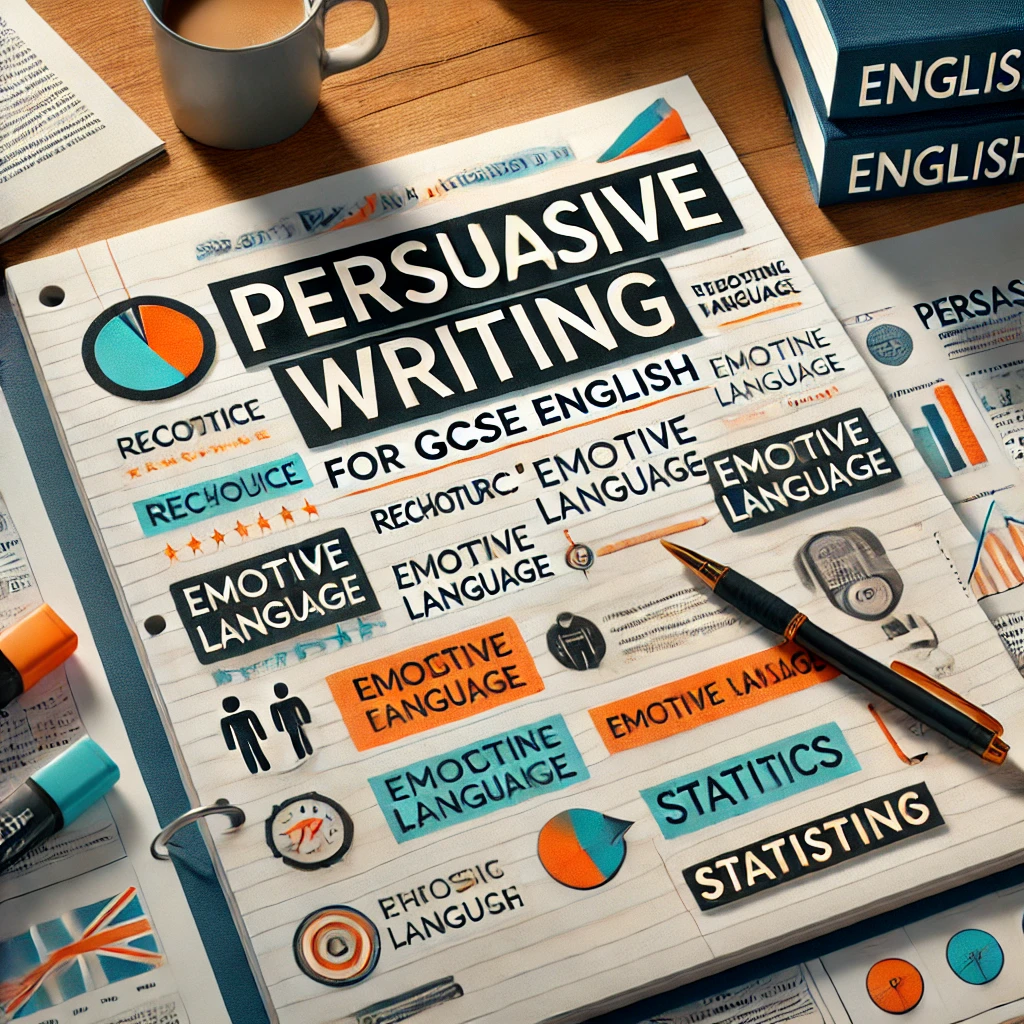Effective Persuasive Writing Strategies for GCSE English Language

Persuasive writing is a foundational component of the GCSE English curriculum, where students are tasked with crafting texts that aim to convince or influence the reader’s thoughts and actions. This form of writing is not only a critical exam component but also a vital skill in everyday communication.
In academic settings, it enables students to construct compelling arguments and express their viewpoints effectively, catering to a specified audience and purpose as outlined by exam boards like AQA, OCR, and Edexcel.
The significance of persuasive writing extends beyond the classroom, it is equally important in real-life scenarios. Whether it’s composing a convincing cover letter for a job application, drafting a persuasive speech for a community project, or even debating in social and political domains, the ability to sway an audience is invaluable.
This skill helps individuals articulate their positions clearly and confidently, fostering a capacity for advocacy and negotiation that is beneficial in numerous professional and personal contexts.
Core Persuasive Techniques
Persuasive writing in GCSE English Language hinges on the effective use of rhetorical devices, primarily ethos, pathos, and logos. Understanding and mastering these techniques can significantly enhance a student’s ability to craft compelling arguments and engage their audience.
Ethos: Establishing Credibility

Ethos refers to the ethical appeal or the credibility of the speaker or writer. In persuasive writing, ethos involves the author establishing authority and trustworthiness on the subject matter. For instance, a student could bolster their ethos by citing authoritative sources, demonstrating knowledge of the topic, or highlighting personal experience or expertise.
Example in Writing:
-
- In a persuasive essay on climate change, a student could reference leading climate scientists and include relevant data to enhance credibility.
Integration Tip:
-
- Teach students to establish ethos by integrating reputable sources and displaying a clear understanding of the topic. Encouraging them to write in a respectful and informed tone also helps in building authority.
Pathos: Appealing to Emotions

Pathos makes use of emotional appeal to persuade the audience. This technique involves connecting with the audience on an emotional level, using language that evokes feelings such as empathy, anger, or joy. Effective use of pathos can make the audience feel what the writer wants them to feel, thus swaying their opinions or actions.
Example in Writing:
-
- An essay arguing against animal cruelty might use vivid descriptions of suffering animals to evoke empathy and anger, compelling readers to support animal rights.
Integration Tip:
-
- Encourage students to use vivid language, personal anecdotes, or rhetorical questions that provoke emotional responses. Discuss the ethical implications of emotional manipulation and stress the importance of balancing pathos with factual content.
Logos: Logical Reasoning

Logos involves the use of logic and reason. This technique is grounded in presenting factual, logical arguments that appeal to the audience’s rationality. It includes the use of statistics, facts, analogies, and logical reasoning.
Example in Writing:
-
- In persuading readers to adopt renewable energy, a student might present statistics on how renewable energy reduces carbon footprints and saves money in the long term.
Integration Tip:
-
- Train students to structure their arguments logically. Teach them how to use data and evidence effectively, and how to construct arguments that lead logically from premises to conclusion.
Combining Ethos, Pathos, and Logos
The most compelling persuasive texts often blend ethos, pathos, and logos. Students should learn how to evaluate their audience and purpose to balance these techniques appropriately, adapting their approach based on the context and desired outcome.
Integration into Student Writing:
-
- Practice sessions where students create short persuasive pieces using each technique individually and then combining them.
-
- Peer review activities to analyze and give feedback on the use of rhetorical devices.
By deeply understanding and applying these core persuasive techniques, students can enhance their writing significantly, making it more effective and engaging for their audience.
Structuring Arguments

A well-structured argument is the backbone of effective persuasive writing. In GCSE English, students are required to present their arguments clearly and logically to persuade the reader effectively. This section provides a guide on planning and structuring persuasive essays, emphasizing the importance of a strong thesis statement, supporting arguments, and the use of transitional phrases.
Planning Your Argument
Before writing, it’s crucial for students to outline their main points and decide on the order in which they will present them. This planning stage involves:
-
- Brainstorming to generate ideas and possible angles for the argument.
-
- Organising these ideas into a logical sequence that builds towards a persuasive conclusion.
-
- Identifying evidence that supports each point, such as statistics, quotes, or examples.
Crafting a Strong Thesis Statement
The thesis statement is a sentence that sums up the main point of the essay and guides the direction of the arguments. It should be:
-
- Clear and concise: Directly state the position without ambiguity.
-
- Argumentative: Make a claim that requires evidence and defense, not merely a statement of fact.
-
- Positioned effectively: Typically placed at the end of the introduction to serve as a transition into the body of the essay.
Example: “Implementing a nationwide curricular focus on environmental education in primary schools is essential for fostering a generation that values sustainable practices.”
Developing Supporting Arguments
Each paragraph in the body of the essay should focus on a single supporting argument that relates back to the thesis. These paragraphs should:
-
- Start with a topic sentence: Clearly state the main idea of the paragraph.
-
- Include supporting details: Use evidence and examples to substantiate the argument.
-
- Explain significance: Discuss why this point is relevant to the thesis.
Using Transitional Phrases
Transitional phrases enhance the flow and coherence of an essay by linking ideas smoothly. They help readers understand the relationship between different parts of the text. Here are a few types:
-
- To show addition: “Furthermore,” “Moreover,” “In addition,”
-
- To provide contrast: “However,” “On the other hand,” “Although,”
-
- To show cause and effect: “Therefore,” “As a result,” “Consequently,”
-
- To conclude: “In conclusion,” “To summarise,” “Finally,”
Integration into Student Writing:
-
- Practice crafting thesis statements and topic sentences in class.
-
- Exercises that involve rearranging paragraphs to create a logical flow using transitional phrases.
-
- Peer review sessions where students give feedback on the clarity and effectiveness of each other’s arguments.
By mastering the art of structuring arguments, students can significantly improve the persuasiveness of their writing, which is not only crucial for academic success in GCSE English but also a valuable skill in many areas of life.
Engaging the Reader
Engaging the reader is essential in persuasive writing, as it ensures the audience is invested from the beginning and remains interested throughout the piece. This section explores various techniques to capture and maintain the reader’s attention in GCSE English essays, including the use of rhetorical questions, anecdotes, striking statistics, emotive language, and personal pronouns.
Hooking the Reader
1. Rhetorical Questions: These are questions posed for effect, with no answer expected, serving to engage the reader’s thoughts. For instance, starting an essay with “Have you ever wondered how much an average family wastes food annually?” immediately involves the reader by prompting them to think about the issue.
2. Anecdotes: Brief, interesting stories related to the essay’s topic can be highly effective. They add a personal touch and can make the argument more relatable. Opening with a personal anecdote about someone affected by the issue being discussed creates a narrative interest that encourages further reading.
3. Striking Statistics: Starting with a compelling statistic grabs attention by presenting the reader with hard, impactful facts. For example, beginning an essay on texting and driving with “Did you know that over 25% of all car accidents are caused by texting and driving?” highlights the significance of the issue.
4. Emotive Language: Words chosen to evoke emotions can significantly strengthen the impact of the argument. Descriptive language that elicits feelings such as sympathy, fear, excitement, or anger can motivate the reader to continue engaging with the material.
5. Personal Pronouns: Using words like “you,” “we,” and “our” makes the text more direct and personal. This approach speaks directly to the reader, making them feel involved in the discussion and part of the collective on whom the issue has an impact.
Examples and Integration into Writing
-
- When discussing climate change, a statistic like “By 2050, rising sea levels could displace over 150 million people globally” can be a powerful opener.
-
- An anecdote about a personal experience with cyberbullying could start a persuasive essay on stricter internet regulations.
-
- Use emotive language effectively by describing a scene vividly to draw readers into the emotional landscape of the topic.
Practice Application
-
- Encourage students to collect interesting anecdotes and statistics as part of their research process.
-
- Have students write practice paragraphs that incorporate these techniques and receive feedback on their effectiveness.
-
- Discuss the impact of different types of language in class discussions to refine their understanding and usage of emotive words.
By employing these techniques, students can learn to write more engaging and effective persuasive essays that not only meet the criteria for GCSE English but also prepare them for writing in a variety of contexts beyond school.
Overcoming Counterarguments
Effectively addressing and refuting counterarguments is a crucial aspect of persuasive writing. This skill not only demonstrates a writer’s ability to engage critically with different viewpoints but also strengthens their own argument by preemptively addressing potential objections. Here’s how GCSE English students can master this technique.
Strategies for Anticipating Counterarguments
-
- Research Thoroughly: Understand all aspects of the topic, including common objections and opposing views. This preparation enables the writer to predict potential counterarguments and plan responses.
-
- Put Yourself in the Opponent’s Shoes: Temporarily adopting the opposing viewpoint can be a valuable exercise. This helps in understanding the logic and emotional appeal behind the counterarguments, making it easier to address them effectively.
-
- List Possible Objections: Before writing, list the most likely objections an opponent might raise. This list will serve as a guide to structuring the rebuttal sections of the essay.
Refuting Counterarguments
-
- Direct Refutation: Address the counterargument head-on by presenting evidence that directly contradicts it. For example, if the counterargument is that renewable energy is too expensive, the refutation could include recent statistics showing the cost-effectiveness of solar and wind energy solutions.
-
- Compromise: Sometimes, acknowledging the validity of a counterargument and then showing how your proposition can accommodate or improve upon these concerns can be persuasive. This not only shows flexibility but also enhances the credibility of the writer.
-
- Turn the Argument Against Itself: Use the logic of the counterargument to support your own position. For instance, if the counterargument claims that banning plastic bags would inconvenience customers, argue that this minor inconvenience is a necessary step towards significant environmental benefits, which aligns with broader public goals like health and safety.
The Importance of Counter-Arguing
-
- Enhances Credibility: Demonstrating awareness of opposing views and respectfully addressing them shows depth of understanding and a balanced approach, which enhances the author’s credibility.
-
- Strengthens the Argument: By successfully refuting counterarguments, the writer not only reaffirms their position but also minimizes the impact of opposition.
-
- Engages the Reader: A well-argued piece that considers different perspectives is more engaging and thought-provoking for readers. It challenges them to think critically about the issue.
Incorporating Counterarguments in Student Writing
-
- Structured Practice: Provide students with practice scenarios where they must identify potential counterarguments and respond to them. This could be done through classroom debates, written exercises, or group discussions.
-
- Peer Review: Encourage students to present counterarguments in peer review sessions and allow classmates to offer refutations. This collaborative approach can help students refine their persuasive techniques.
-
- Example Analysis: Analyze persuasive texts that effectively address counterarguments. Discuss what makes these examples effective and how the techniques can be applied in their writing.
Teaching students to effectively anticipate and counteract opposing arguments will equip them with the skills to write more convincing and comprehensive persuasive essays, crucial not only for academic success but for any argumentative writing they may undertake in the future.
Advanced Writing Tips
Advanced writing techniques are essential for crafting persuasive GCSE English essays that stand out. This section focuses on how students can vary their sentence structures and vocabulary to maintain reader interest and how to adopt the appropriate tone to suit the target audience.
Varying Sentence Structures and Vocabulary
-
- Mix Sentence Lengths and Types: Combining shorter, impactful sentences with longer, more descriptive ones can keep the reader engaged and enhance the rhythm of the writing. For example, a short sentence can provide a punchy, memorable statement, while longer sentences can develop complex ideas or create a build-up to a crucial point.
-
- Use Active Voice Predominantly: Active voice tends to be more direct and vigorous than passive voice, which can make the argument more compelling. Encouraging students to write primarily in active voice can also help maintain clarity and keep the audience engaged.
-
- Incorporate Different Sentence Starters: Avoid starting every sentence the same way as it can make the text monotonous. Teach students to use a variety of conjunctions, adverbs, and phrases to begin their sentences, which can help vary the flow and introduce ideas dynamically.
-
- Advanced Vocabulary: While it’s important to use precise and relevant vocabulary, caution students against overusing complex words, which can alienate readers. Instead, focus on using specific and robust vocabulary that accurately conveys arguments and enhances persuasion.
Adopting the Appropriate Tone
-
- Understand the Audience: The tone of the essay should reflect the intended audience. If the essay is aimed at a younger audience, a more casual and relatable tone might be appropriate. Conversely, for a formal audience, a more structured and formal tone is necessary.
-
- Purpose-Driven Tone: The tone should also reflect the purpose of the essay. For instance, if the purpose is to alarm the reader about environmental issues, a more urgent and serious tone is suitable. If the goal is to persuade parents to support school reforms, a respectful and reasoned tone might be more effective.
-
- Cultural Sensitivity: It’s important to consider cultural context when determining tone, ensuring that the language and approach are respectful and appropriate for all potential readers.
-
- Consistency Is Key: While varying sentence structures and vocabulary can add interest, maintaining a consistent tone throughout the essay is crucial for coherence and to strengthen the overall argument.
Integration into Student Writing
-
- Practice Exercises: Regularly include exercises that focus on writing sentences in different structures and using varied vocabulary.
-
- Peer Feedback: Utilize peer review sessions to provide feedback on tone and style, helping students understand how their writing is perceived by others.
-
- Writing Workshops: Organize workshops that focus on tone, style, and advanced language skills, where students can learn and practice these concepts in a supportive environment.
To Sum-Up
Throughout this guide, we have delved deeply into the various techniques that form the essence of persuasive writing in GCSE English. From the strategic use of rhetorical devices like ethos, pathos, and logos to structuring compelling arguments and engaging readers effectively, each element is pivotal in crafting impactful essays. Furthermore, the ability to anticipate and skillfully refute counterarguments enriches the writer’s credibility and argumentative depth.
Recap of Key Techniques:
-
- Ethos, Pathos, and Logos: The foundational rhetorical devices for persuading an audience.
-
- Structured Arguments: Building essays around a robust thesis statement supported by coherent, well-organized arguments.
-
- Reader Engagement: Employing rhetorical questions, anecdotes, and factual data to captivate and maintain reader interest.
-
- Counterarguments: Enhancing arguments by addressing and overcoming opposing viewpoints.
-
- Advanced Writing Practices: Varying sentence structure and vocabulary to sustain engagement and match the audience’s expectations.
The practice of these techniques extends beyond examinations, equipping students with essential skills for various real-world applications. Effective persuasive writing can influence opinions, encourage changes, and foster advocacy, making it a powerful tool in both academic and personal realms.
Continual Practice and Skill Enhancement: Mastering persuasive writing requires consistent practice and a commitment to improvement. Students are encouraged to engage actively in revising their essays, participating in writing workshops, and seeking constructive feedback. By embracing a proactive approach to learning and applying these persuasive techniques, students can significantly enhance their writing skills.
For students seeking additional support or aiming to further refine their persuasive writing skills in preparation for their GCSE English exams, expert guidance is available. Consider exploring GCSE English Language tutors who can provide personalised coaching tailored to individual learning needs, ensuring that students not only excel in their exams but also develop a profound capability in persuasive writing.
By continuously honing these skills, students will not only excel academically but also gain valuable tools for effective communication across various aspects of life.

GCSE Physics Equations – Formulae by Topics

Top 8 Best State Schools in the UK
Find a Tutor
Online tutors from top UK universities
Recent Posts
- Failed Maths GCSE 3 Times? Here’s How to Move Forward
 by Anna Giunashvili
by Anna Giunashvili - Changing Sets in GCSE Maths: What It Really Means
 by Nini Jishkariani
by Nini Jishkariani - Energy Equation In Physics – Everything You Need To Know
 by Anna Giunashvili
by Anna Giunashvili



